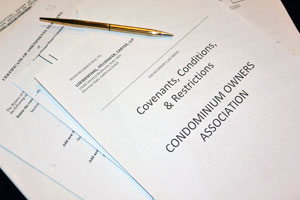There’s nothing like a full-scale disaster to force an Association and its counsel to take a long serious look at the documents which the Board, the members, the property manager and prospective buyers and lenders rely on in evaluating any number of issues that effect them almost on a daily basis. On January 17, 1994, the Northridge earthquake provided just such a stimulus for this type of analysis. The analysis became dramatically necessary simply because the practical realities of disaster management made it abundantly clear that certain fairly standard provisions appearing in countless sets of C, C & R’s did not adequately address problems of the magnitude encountered by many homeowner’s associations in Southern California and particularly in the San Fernando Valley. In the aftermath of the crisis and the rebuilding effort that has occupied so much of our time over the last 19 months, now is the time for association clients to culminate this rebuilding effort by rehabilitating the documents which can make the task of running an association either efficient and in the best interests of the members or, alternatively a constant struggle to accomplish even basic goals. This article is intended to identify the questions to ask of association boards and yourself to determine whether the governing documents of your association should be revised. If you answer several of these questions affirmatively, it is my opinion that your association and its members need, and deserve the benefits of a rehabilitated set of governing documents.
QUESTION NO. ONE:
Are the C, C & R’s more than 15 years old? If they are and have not been revised or updated periodically, the document is probably deficient in that it does not reflect much of the legislation enacted specifically to govern the conduct of Homeowners Associations. Numerous laws have been passed since the advent of the Davis-Stirling Act in the early 1980’s which directly control many important aspects of association administration. One of the primary purposes of the declaration is to give notice to the members of their rights and obligations. A few examples include the alternative dispute resolution provisions, the insurance requirements to prevent individual member liability, and the use of reserve funds for emergency purposes among others. A revised set of C, C & R’s which reference all the current code requirements will meet all the disclosure obligations placed on the board and manager and eliminate the problem areas encountered over the history of the Association.
QUESTION NO. TWO:
Do the documents contain numerous references to the developer and are there class A and B voting rights mentioned? If the developer is gone from the project, there is no good reason to keep clauses in the documents that refer only to the developer and which are invariably confusing. Removal of these items is quick, simple and makes the document more relevant to the present.
QUESTION NO. THREE:
Did the SBA require the documents to be amended to obtain an earthquake loan? If this was the case, the documents should be reviewed with an eye to mitigating any future collection problems concerning repayment of the loan. I also strongly recommend that the amendment address a particular protocol to follow in the presentation of information needed to permit the owners to vote on the loan. So much misinformation was disseminated regarding collection and liens that it can be spelled out clearly.
QUESTION NO. FOUR:
Is the board required to obtain at least two bids from a contractor and award the contract to the lowest? This is not the most advantageous and cost effective way for an association to let repair work of any magnitude. It fails to take into consideration that the board and the association can better achieve their mutual goals by using professionals to negotiate a guaranteed maximum price contract for less cost with a better result. A recommended amendment would give the board clear authority to exercise discretion to engage the most qualified contractor at a competitive price.
QUESTION NO. FIVE:
Do the documents establish a short time period within which to vote to repair major damage or destruction? Many of our clients had documents which required the association to record a certificate of intention to rebuild within 90 days after the damage or destruction occurred. It became obvious after the earthquake that 90 days was grossly inadequate to make informed decisions because it was rare that reliable information could be obtained concerning the cost of repairs within that time, let alone know whether the insurance carrier would voluntarily cover the loss. An amendment to the document requires that the association and its board perform reasonable due diligence prior to taking the vote.
QUESTION NO. SIX:
Is your board repeatedly seeking legal opinions regarding provisions in the documents that are not easy to understand. I cannot tell you how many different times I was asked to interpret the “common area” versus “unit interior” provisions.The fact that this is an important legal document does not require that it be beyond comprehension except to an attorney. The use of clear and “non-legalese” in revised documents can avoid the necessity of obtaining constant legal opinions. This is not to say that they will never be needed, but a document that is designed to inform non-lawyers should lessen the need for interpretation. In most cases it will eliminate many minor disputes between the board and individual owners because both will now be able to understand what the controlling provisions mean.
QUESTION NO. SEVEN:
Is your association confronted with important situations which the governing documents simply do not address? A simple amendment to address specific problems can be easily inserted in the overall amendment process such that it is consistent and legal. Many amendment provisions consist of rules which were put into effect by boards previously but are so important that they are appropriately made part of the recorded document. The amendment process, if approached thoughtfully, can allow the association to “hand-craft” its documents to ensure an efficient and harmonious operation.
QUESTION NO. EIGHT:
Is your association unincorporated or is the project an “own your own apartment” type project? If it is then I strongly recommend that the documents be reviewed because there are many important issues to be addressed in that context. One of the most timely aspect is that SBA refused to allow such associations to obtain a disaster loan without collateral, instead requiring each owner to borrow monies secured by their unit. The process of incorporation is simple and does not take a great deal of time. Since nearly all new declarations establish a non-profit mutual benefit corporation, if your association falls into this category, you have likely answered number one yes also.
An association’s governing documents are its bible and its roadmap. As we all know, road maps grow out of date over time and bibles can be written in archaic language, making both difficult to use. If you have answered several of the above questions with a “yes”, you should give strong consideration to undertaking an overhaul of the association documents. In the long run it will educate the members more effectively than a hundred opinion letters that are not read and eliminate many unnecessary legal costs related to disputes over the meaning of certain provisions.
As with most important decisions, one important factor is the cost of the amendment process. The cost of an overhaul of the documents will largely be dependent upon how extensive the rehabilitation is and that will be determined by the board or committee appointed to work with the attorney. The cost is not insubstantial so the board and the membership needs to be aware of the cost ahead of time, at least in the form of an estimate. Most attorneys will provide an estimate based on the extent of the changes desired. These legal fees can run from $3,000.00 to $10,000.00 depending on the amount of changes and the time spent laying them out.
In my opinion, this is money that it well-spent by an association because it reflects a desire to create and maintain a business plan that affirmatively addresses the problems faced now and looks for a long term solution. Oftentimes the most difficult task confronting me concerning association clients is to convince them they need to approach their problems as a business. The amendment process underscores that business approach and can go along way towards enlightening board members and owners to that reality.
Finally, in many cases, the savings realized because of the new documents and the amendment process itself will justify the short term expense. Even it you undertake to amend the documents it does not guarantee that the amendment will pass. Therefore, it is essential that as part of the process the members have ample opportunity to participate and that timely disclosure is given. I generally like to distribute a draft thirty or more days before the vote and have a question and answer session with the membership prior to the vote. I find that this eliminates confusion and assures the owners that the board is not trying to “pull a fast one.” Public relations is definitely an integral aspect of a successful amendment campaign. If you have questions or would like an estimate on revising your association documents, please feel free to contact me.


